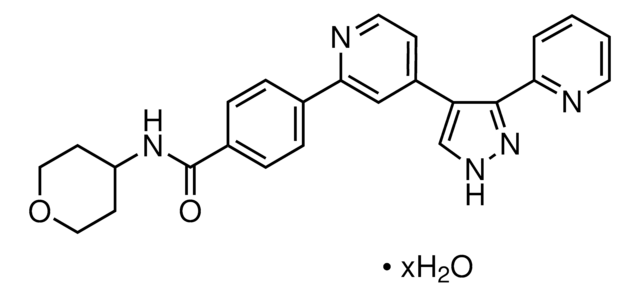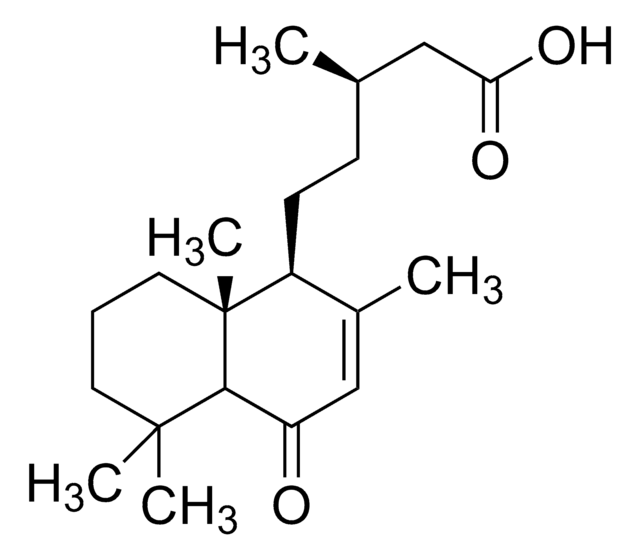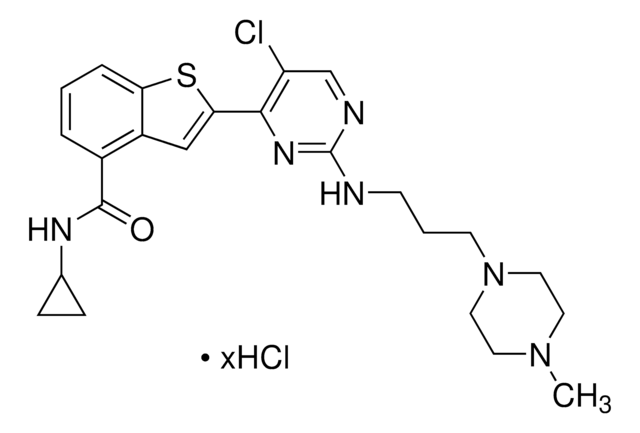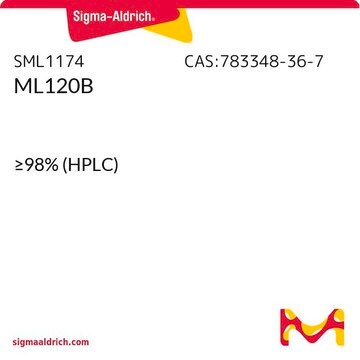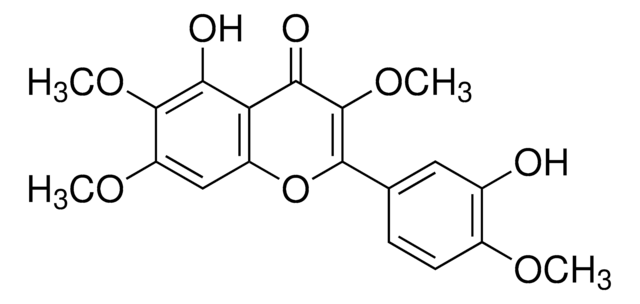H9146
13(S)-Hydroxyoctadeca-9Z,11E-dienoic acid
90-100 μg/mL in ethanol, ≥98%
Synonyme(s) :
13(S)-HODE
Se connecterpour consulter vos tarifs contractuels et ceux de votre entreprise/organisme
About This Item
Formule empirique (notation de Hill) :
C18H32O3
Numéro CAS:
Poids moléculaire :
296.44
Numéro CE :
Numéro MDL:
Code UNSPSC :
12352200
ID de substance PubChem :
Nomenclature NACRES :
NA.77
Produits recommandés
Niveau de qualité
Essai
≥98%
Concentration
90-100 μg/mL in ethanol
Température de stockage
−20°C
Chaîne SMILES
CCCCC[C@H](O)\C=C\C=C/CCCCCCCC(O)=O
InChI
1S/C18H32O3/c1-2-3-11-14-17(19)15-12-9-7-5-4-6-8-10-13-16-18(20)21/h7,9,12,15,17,19H,2-6,8,10-11,13-14,16H2,1H3,(H,20,21)/b9-7-,15-12+/t17-/m0/s1
Clé InChI
HNICUWMFWZBIFP-IRQZEAMPSA-N
Actions biochimiques/physiologiques
Expression of 15-lipoxygenase-1 (15-LOX-1) and its main product, 13(S)-HODE, are decreased in human colorectal and esophageal cancers. Certain non-steroidal anti-inflammatory drugs (NSAIDs) can induce apoptosis in human colon cancer cells by increased expression of 15-LOX-1, which down-regulates PPAR-delta through 13-HODE.
PPARγ agonist
Caractéristiques et avantages
This compound is featured on the Nuclear Receptors (PPARs) page of the Handbook of Receptor Classification and Signal Transduction. To browse other handbook pages, click here.
Conditionnement
Packaged under Argon.
Mention d'avertissement
Danger
Mentions de danger
Conseils de prudence
Classification des risques
Eye Irrit. 2 - Flam. Liq. 2
Code de la classe de stockage
3 - Flammable liquids
Classe de danger pour l'eau (WGK)
WGK 1
Point d'éclair (°F)
57.2 °F
Point d'éclair (°C)
14 °C
Faites votre choix parmi les versions les plus récentes :
Déjà en possession de ce produit ?
Retrouvez la documentation relative aux produits que vous avez récemment achetés dans la Bibliothèque de documents.
Claus Schneider et al.
Cancer metastasis reviews, 30(3-4), 277-294 (2011-10-18)
Cancer initiation and progression are multistep events that require cell proliferation, migration, extravasation to the blood or lymphatic vessels, arrest to the metastatic site, and ultimately secondary growth. Tumor cell functions at both primary or secondary sites are controlled by
Shing Hwa Liu et al.
British journal of pharmacology, 160(8), 1963-1972 (2010-07-24)
Peroxisome proliferator-activated receptor-gamma (PPAR-gamma), COX-2 and 15-lipoxygenase (LOX)-1 have been shown to be involved in tumour growth. However, the roles of PPAR-gamma, COX-2 or 15-LOX-1 in gastric tumourigenesis remain unclear. Here, we investigate the role of 15-LOX-1 induction by honokiol
Ming-Yue Li et al.
American journal of respiratory cell and molecular biology, 43(6), 674-683 (2010-01-19)
Peroxisome proliferator-activated receptor (PPAR)-α and PPARγ participate in cell proliferation and apoptosis. Few studies have simultaneously investigated both PPARα and PPARγ in lung cancers in vivo. The roles of PPARα and -γ were investigated in the development of pulmonary tumors
Ulaganathan Mabalirajan et al.
Journal of applied physiology (Bethesda, Md. : 1985), 107(4), 1285-1292 (2009-07-25)
We showed recently that IL-4 causes mitochondrial dysfunction in allergic asthma. IL-4 is also known to induce 12/15-lipoxygenase (12/15-LOX), a potent candidate molecule in asthma. Because vitamin E (Vit-E) reduces IL-4 and inhibits 12/15-LOX in vitro, here we tested the
Anna Z Pollack et al.
American journal of epidemiology, 175(7), 645-652 (2012-02-04)
Exposures to cadmium, lead, and mercury are associated with adverse health effects, including cardiovascular disease, which may be promoted by lipid peroxidation. The authors examined cadmium, lead, and mercury in relation to plasma levels of F(2)-8α isoprostanes (isoprostane), 9-hydroperoxy-10,12-octadecadienoic acid
Notre équipe de scientifiques dispose d'une expérience dans tous les secteurs de la recherche, notamment en sciences de la vie, science des matériaux, synthèse chimique, chromatographie, analyse et dans de nombreux autres domaines..
Contacter notre Service technique